*NURSING > QUESTIONS & ANSWERS > SOLVED!!! NR 509 COMPREHENSIVE REVIEW OF JARVIS 7TH EDITION CHAPTER 13 QUESTIONS (Head, Face, and Ne (All)
SOLVED!!! NR 509 COMPREHENSIVE REVIEW OF JARVIS 7TH EDITION CHAPTER 13 QUESTIONS (Head, Face, and Neck, Including Regional Lymphatics: Physical Examination & Health Assessment)
Document Content and Description Below
SOLVED!!! NR 509 COMPREHENSIVE REVIEW OF JARVIS 7TH EDITION CHAPTER 13 QUESTIONS (Head, Face, and Neck, Including Regional Lymphatics: Physical Examination & Health Assessment) ◇This material contai... ns comprehensive summary of information in the form of great test questions with descriptive answers helpful for exams study. Thorough Review of Jarvis 7th Edition Chapter 13 Questions. All the best Champions!!! _____ MULTIPLE CHOICE 1. A physician tells the nurse that a patient’s vertebra prominens is tender and asks the nurse to reevaluate the area in 1 hour. The area of the body the nurse will assess is: Just above the diaphragm. a. b. Just lateral to the knee cap. c. At the level of the C7 vertebra. d. At the level of the T11 vertebra. ANS: C The C7 vertebra has a long spinous process, called the vertebra prominens, which is palpable when the head is flexed. DIF: Cognitive Level: Applying (Application) REF: p. 251 MSC: Client Needs: Physiologic Integrity: Physiologic Adaptation 2. A mother brings her 2-month-old daughter in for an examination and says, “My daughter rolled over against the wall, and now I have noticed that she has this spot that is soft on the top of her head. Is something terribly wrong?” The nurse’s best response would be: “Perhaps that could be a result of your dietary intake during pregnancy.” a. b. “Your baby may have craniosynostosis, a disease of the sutures of the brain.” c. “That ‘soft spot’ may be an indication of cretinism or congenital hypothyroidism.” d. “That ‘soft spot’ is normal, and actually allows for growth of the brain during the first year of your baby’s life.” ANS: D Membrane-covered “soft spots” allow for growth of the brain during the first year of life. They gradually ossify; the triangular-shaped posterior fontanel is closed by 1 to 2 months, and the diamond-shaped anterior fontanel closes between 9 months and 2 years. DIF: Cognitive Level: Applying (Application) MSC: Client Needs: Health Promotion and Maintenance 3. The nurse notices that a patient’s palpebral fissures are not symmetric. On examination, the nurse may find that damage has occurred to which cranial nerve (CN)? a. III b. V c. VII d. VIII ANS: C Facial muscles are mediated by CN VII; asymmetry of palpebral fissures may be attributable to damage to CN VII (Bell palsy). DIF: Cognitive Level: Applying (Application) REF: p. 259 MSC: Client Needs: Physiologic Integrity: Physiologic Adaptation REF: p. 2554. A patient is unable to differentiate between sharp and dull stimulation to both sides of her face. The nurse suspects: a. Bell palsy. b. Damage to the trigeminal nerve. c. Frostbite with resultant paresthesia to the cheeks. d. Scleroderma. ANS: B Facial sensations of pain or touch are mediated by CN V, which is the trigeminal nerve. Bell palsy is associated with CN VII damage. Frostbite and scleroderma are not associated with this problem. DIF: Cognitive Level: Applying (Application) REF: pp. 252-253 MSC: Client Needs: Physiologic Integrity: Physiologic Adaptation 5. When examining the face of a patient, the nurse is aware that the two pairs of salivary glands that are accessible to examination are the ___________ and ___________ glands. a. Occipital; submental b. Parotid; jugulodigastric c. Parotid; submandibular d. Submandibular; occipital ANS: C Two pairs of salivary glands accessible to examination on the face are the parotid glands, which are in the cheeks over the mandible, anterior to and below the ear; and the submandibular glands, which are beneath the mandible at the angle of the jaw. The parotid glands are normally nonpalpable. DIF: Cognitive Level: Understanding (Comprehension) REF: p. 253 MSC: Client Needs: Safe and Effective Care Environment: Management of Care 6. A patient comes to the clinic complaining of neck and shoulder pain and is unable to turn her head. The nurse suspects damage to CN ______ and proceeds with the examination by _____________. a. XI; palpating the anterior and posterior triangles b. XI; asking the patient to shrug her shoulders against resistance c. XII; percussing the sternomastoid and submandibular neck muscles d. XII; assessing for a positive Romberg sign ANS: B The major neck muscles are the sternomastoid and the trapezius. They are innervated by CN XI, the spinal accessory. The innervated muscles assist with head rotation and head flexion, movement of the shoulders, and extension and turning of the head. DIF: Cognitive Level: Analyzing (Analysis) REF: p. 260 MSC: Client Needs: Safe and Effective Care Environment: Management of Care 7. When examining a patient’s CN function, the nurse remembers that the muscles in the neck that are innervated by CN XI are the: Sternomastoid and trapezius. a. b. Spinal accessory and omohyoid. c. Trapezius and sternomandibular.d. Sternomandibular and spinal accessory. ANS: A The major neck muscles are the sternomastoid and the trapezius. They are innervated by CN XI, the spinal accessory. DIF: Cognitive Level: Remembering (Knowledge) REF: p. 253 MSC: Client Needs: General 8. A patient’s laboratory data reveal an elevated thyroxine (T4 with an examination of the _____ gland. a. Thyroid ) level. The nurse would proceed b. Parotid c. Adrenal d. Parathyroid ANS: A The thyroid gland is a highly vascular endocrine gland that secretes T4 (T3 ). The other glands do not secrete T4 . DIF: Cognitive Level: Understanding (Comprehension) REF: p. 253 MSC: Client Needs: Safe and Effective Care Environment: Management of Care 9. A patient says that she has recently noticed a lump in the front of her neck below her “Adam’s apple” that seems to be getting bigger. During the assessment, the finding that leads the nurse to suspect that this may not be a cancerous thyroid nodule is that the lump (nodule): a. Is tender. b. Is mobile and not hard. c. Disappears when the patient smiles. d. Is hard and fixed to the surrounding structures. ANS: B Painless, rapidly growing nodules may be cancerous, especially the appearance of a single nodule in a young person. However, cancerous nodules tend to be hard and fixed to surrounding structures, not mobile. DIF: Cognitive Level: Applying (Application) REF: p. 262 MSC: Client Needs: Physiologic Integrity: Physiologic Adaptation 10. The nurse notices that a patient’s submental lymph nodes are enlarged. In an effort to identify the cause of the node enlargement, the nurse would assess the patient’s: a. Infraclavicular area. b. Supraclavicular area. c. Area distal to the enlarged node. d. Area proximal to the enlarged node. ANS: D When nodes are abnormal, the nurse should check the area into which they drain for the source of the problem. The area proximal (upstream) to the location of the abnormal node should be explored. DIF: Cognitive Level: Analyzing (Analysis) [Show More]
Last updated: 1 year ago
Preview 1 out of 13 pages

Buy this document to get the full access instantly
Instant Download Access after purchase
Add to cartInstant download
We Accept:

Reviews( 0 )
$15.00
Document information
Connected school, study & course
About the document
Uploaded On
Sep 13, 2021
Number of pages
13
Written in
Additional information
This document has been written for:
Uploaded
Sep 13, 2021
Downloads
0
Views
49

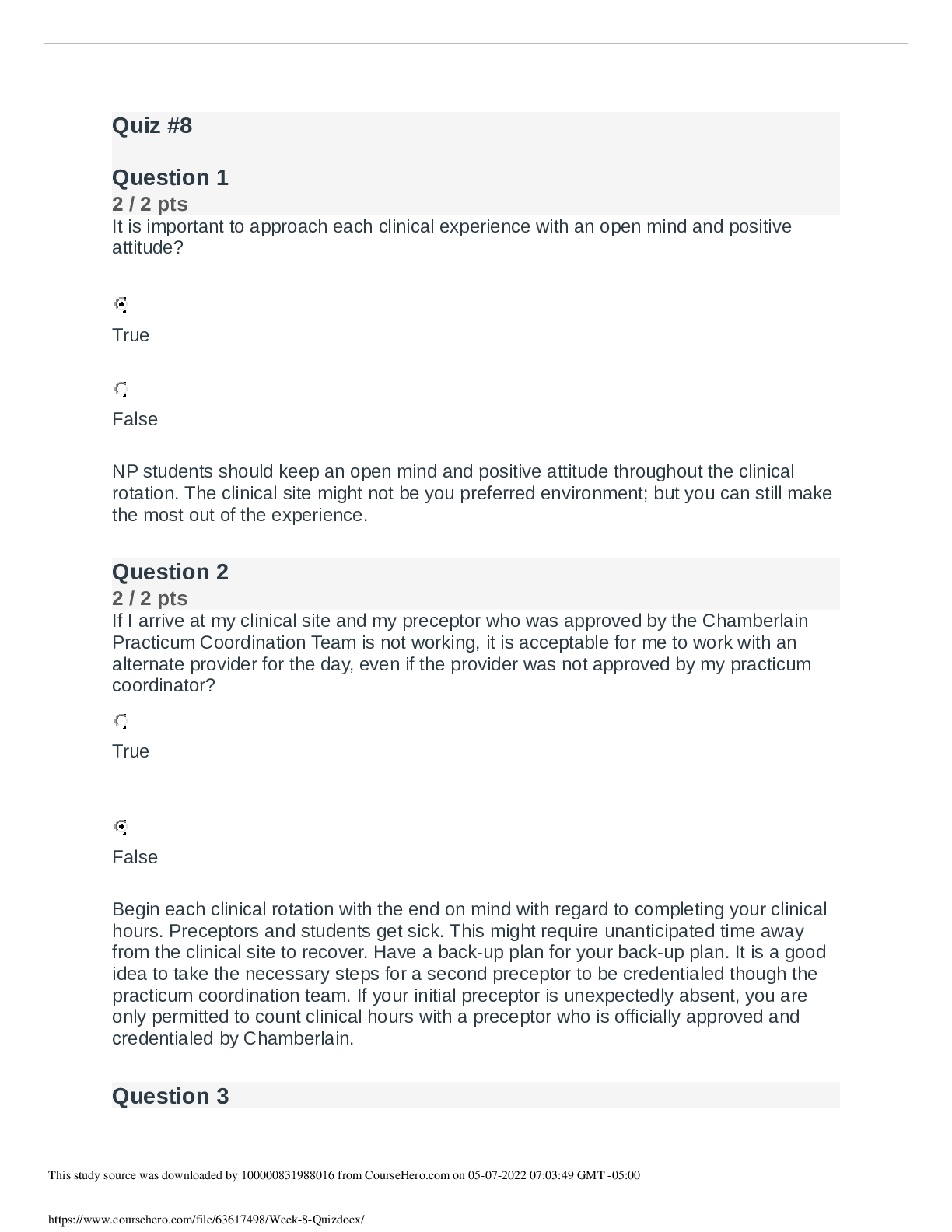


.png)
.png)
.png)
.png)

.png)


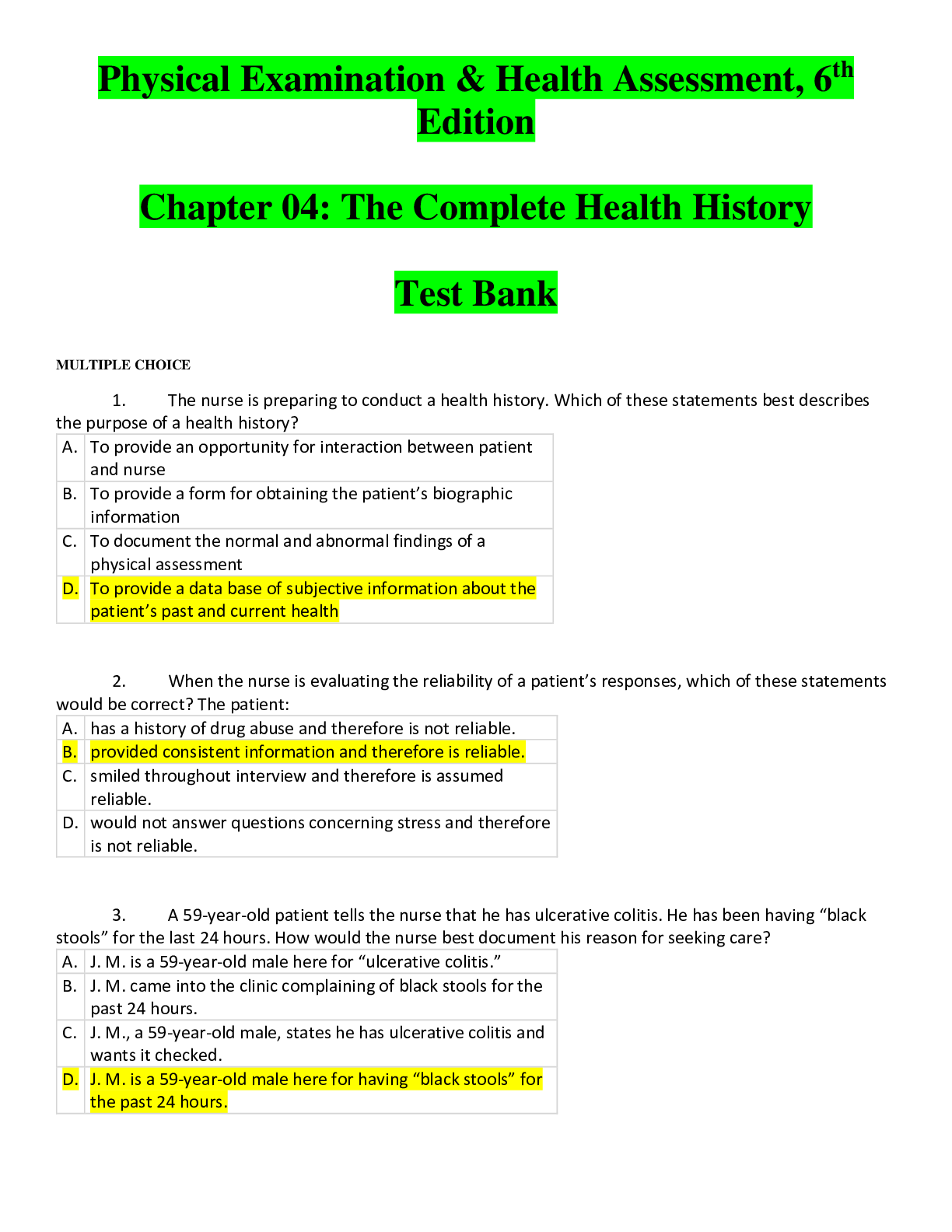
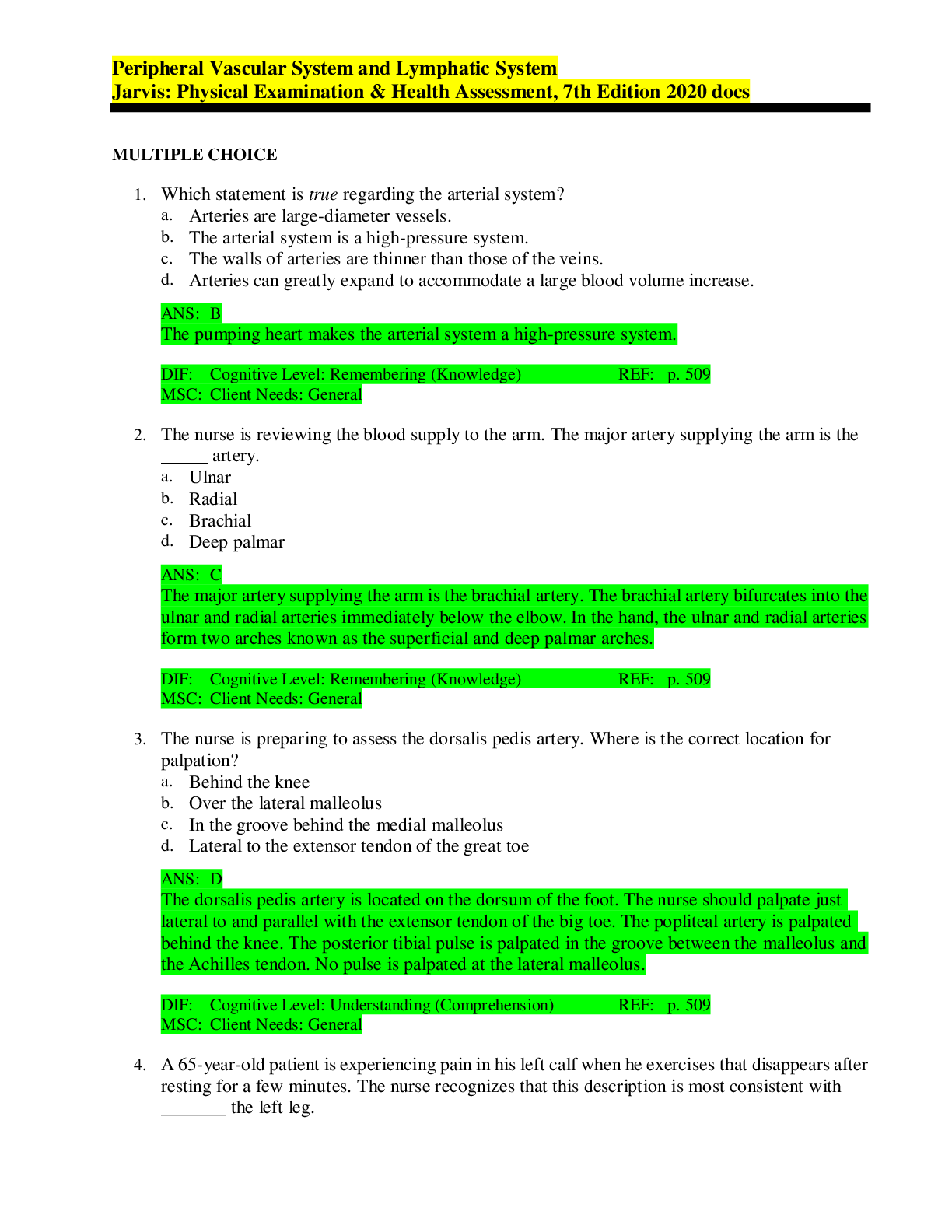
 answers.png)
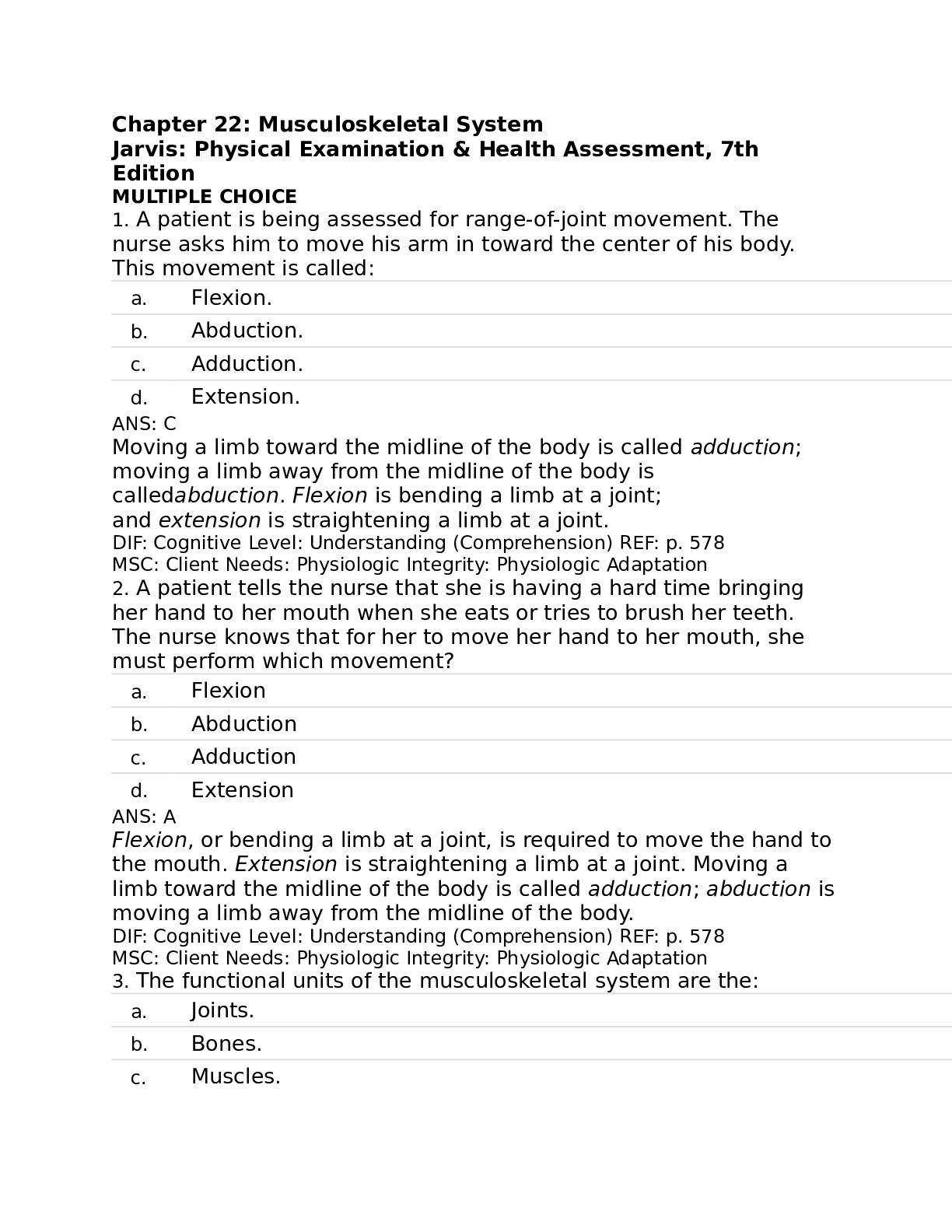
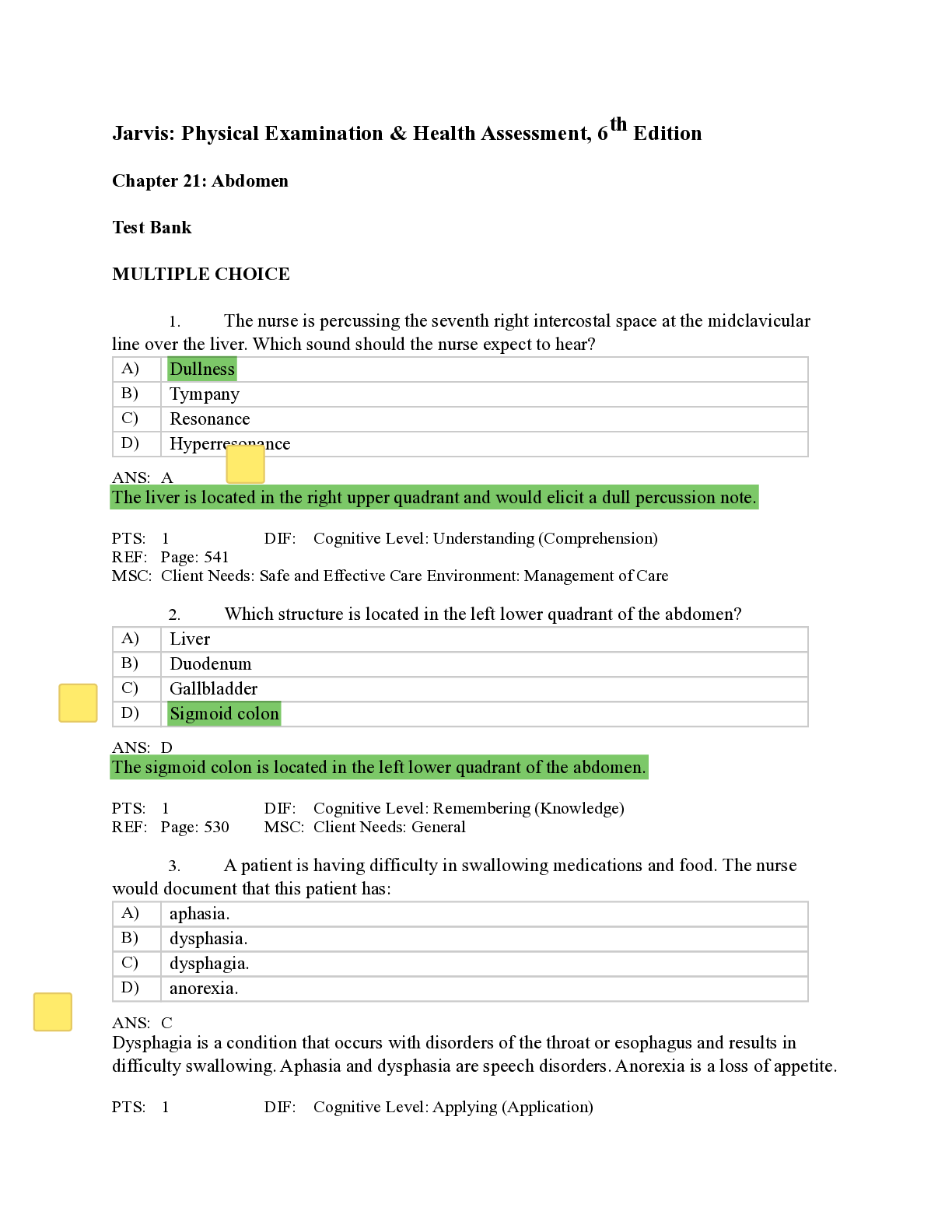
, Latest Questions and Answers with Explanations for Revision, All C.png)
, Latest Questions and Answers with Explanations for Revision, All Correct Latest Review, (La.png)
, Latest Questions and Answers with Explanations for Revision, All Correct Latest Review, (Latest 2021) Correc.png)
, Latest Questions and Answers with Explanations for Revision, All Correct Latest Revie.png)


